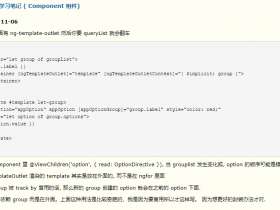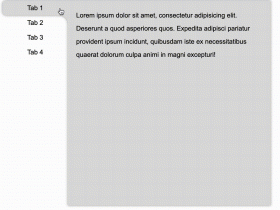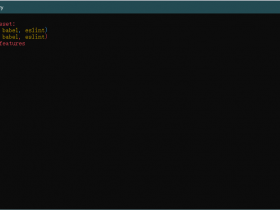- A+
所属分类:Web前端
1.1 Vue简介
1.1.1 官网
1.1.2 介绍与描述
- 动态构建用户界面的 渐进式
JavaScript框架 - 作者:尤雨溪
1.1.3 Vue的特点
- 遵循
MVVM模式 - 编码简洁,体积小,运行效率高,适合移动/PC端开发
- 它本身只关注UI,也可以引入其它第三方库开发项目
1.1.4 与其它JS框架的关联
- 借鉴
Angular的模板和数据绑定技术 - 借鉴
React的组件化和虚拟DOM技术
1.1.5 Vue 周边库
Vue CLI: 项目脚手架Vue ResourceAxiosVue Router: 路由Vuex: 状态管理element-ui:基于Vue的UI组件库(PC端)
......
1.2 初识 Vue
<!DOCTYPE html> <html lang="en"> <head> <meta charset="UTF-8"> <meta http-equiv="X-UA-Compatible" content="IE=edge"> <meta name="viewport" content="width=device-width, initial-scale=1.0"> <title>初识Vue</title> <script src="../js/vue.js"></script> </head> <body> <!-- 初识Vue: 1.想让 Vue工作,就必须创建一个 Vue实例,且要传入一个配置对象; 2.root 容器里的代码依然符合 html 规范,只不过混入了一些特殊的 Vue语法; 3.root 容器里的代码被称为【Vue模板】; 4.Vue 实例和容器是一一对应的; 5.真实开发中只有一个 Vue 实例,并且会配合着组件一起使用; 6.{{xxx}} 中的 xxx 要写 js 表达式,且 xxx 可以自动读取到 data 中的所有属性; 7.一旦 data 中的数据发生改变,那么页面中用到该数据的地方也会自动更新; 注意区分:js 表达式和 js 代码(语句) 1.表达式:一个表达式会产生一个值,可以放在任何一个需要值的地方: (1). a (2). a+b (3). demo(1) (4). x === y ? 'a' : 'b' 2.js代码(语句) (1). if(){} (2). for(){} --> <div id="root"> <h1>Hello {{name}}</h1> </div> <script> // 阻止 Vue 在启动时生成生产提示 // You are running Vue in development mode. // Make sure to turn on production mode when deploying for production. // See more tips at https://vuejs.org/guide/deployment.html Vue.config.productionTip = false // 创建 Vue 实例 new Vue({ // el 用于指定当前 Vue 实例为哪个容器服务,值通常为 css 选择器字符串 el: '#root', // data 用于存储数据,数据供 el 所指定的容器去使用 data: { name: "张三" }, }) </script> </body> </html> 1.3 模板语法
1.3.1 模板的理解
html 中包含了一些 js 语法代码,语法分为两种,分别为:
- 插值语法(双大括号表达式)
- 指令(以v-开头)
1.3.2 插值语法
- 功能:用于解析标签体内容
1.3.3 指令语法
- 功能:解析标签属性、解析标签体内容、绑定事件
- 举例:
v-bind:href='xxxx',xxxx会作为js表达式被解析 - 说明:
Vue中有有很多的指令,此处只是用v-bind举个例子
1.3.4 示例代码
<!DOCTYPE html> <html lang="en"> <head> <meta charset="UTF-8"> <meta http-equiv="X-UA-Compatible" content="IE=edge"> <meta name="viewport" content="width=device-width, initial-scale=1.0"> <title>Vue 模板语法</title> <script src="../js/vue.js"></script> </head> <body> <!-- Vue模板语法有2大类: 1.插值语法: 功能:用于解析标签体内容。 写法:{{xxx}},xxx 是 js 表达式,且可以直接读取到 data 中的所有属性。 2.指令语法: 功能:用于解析标签(包括:标签属性、标签体内容、绑定事件.....)。 举例:v-bind:href="xxx" 或 简写为 :href="xxx",xxx同样要写js表达式,且可以直接读取到 data 中的所有属性。 备注:Vue 中有很多的指令,且形式都是:v-????,此处我们只是拿 v-bind 举个例子。 --> <div id="root"> <h1>插值语法</h1> <h3>你好,{{name}}</h3> <hr></hr> <h1>指令语法</h1> <a href="http://baidu.com">去百度</a> <br/> <a v-bind:href="school.url">去百度</a> <br/> <a :href="school.url">去百度</a> </div> <script> // 阻止 Vue 在启动时生成生产提示 Vue.config.productionTip = false new Vue({ el: "#root", data: { name: "张三", school: { url: "http://baidu.com" } } }) </script> </body> </html> 1.4 数据绑定
1.4.1 单向数据绑定
- 语法:
v-bind:href="xxx"或简写为:href - 特点:数据只能从
data流向页面
1.4.2 双向数据绑定
- 语法:
v-model:value="xxx"或简写为v-model="xxx" - 特点:数据不仅能从
data流向页面,还能从页面流向data
1.4.3 示例代码
<!DOCTYPE html> <html lang="en"> <head> <meta charset="UTF-8"> <meta http-equiv="X-UA-Compatible" content="IE=edge"> <meta name="viewport" content="width=device-width, initial-scale=1.0"> <title>数据绑定</title> <script src="../js/vue.js"></script> </head> <body> <!-- Vue中有2种数据绑定的方式: 1.单向绑定(v-bind):数据只能从 data 流向页面。 2.双向绑定(v-model):数据不仅能从 data 流向页面,还可以从页面流向 data 。 备注: 1.双向绑定一般都应用在表单类元素上(如:input、select等) 2.v-model:value 可以简写为 v-model,因为 v-model默认收集的就是 value 值。 --> <div id="root"> <!-- 单向绑定 --> <!-- 普通写法 --> 单向绑定普通写法:<input type="text" v-bind:value="name"></input> <br/> <!-- 简写 --> 单向绑定简写:<input type="text" :value="name"></input> <hr></hr> <!-- 双向绑定 --> <!-- 普通写法 --> 双向绑定普通写法:<input type="text" v-model:value="name"></input> <br/> <!-- 简写 --> 双向绑定简写:<input type="text" v-model="name"></input> <!-- 如下代码是错误的,因为 v-model只能应用在表单类元素(输入类元素)上 --> <!-- <h2 v-model="name">: v-model is not supported on this element type. If you are working with contenteditable, it's recommended to wrap a library dedicated for that purpose inside a custom component. --> <h2 v-model:x="name"></h2> </div> <script> // 组织 Vue 在启动时生成生产提示 Vue.config.productionTip = false new Vue({ el: "#root", data: { name: "张三" } }) </script> </body> </html> 1.5 MVVM模型
- M:模型(Model):对应
data中的数据 - V:视图(View):模板
- VM:视图模型(ViewModel):
Vue实例对象
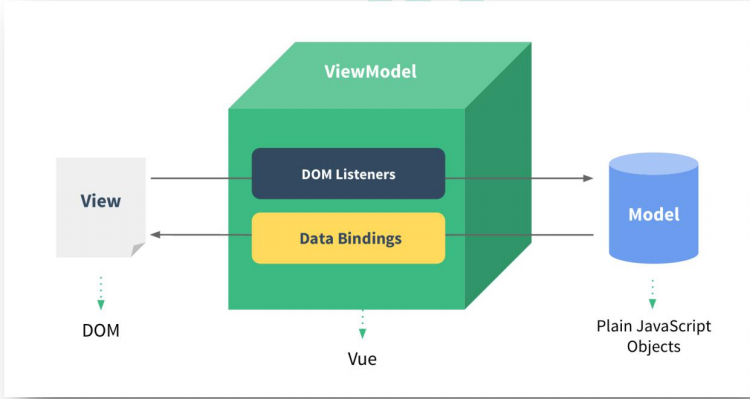
1.6 事件处理
1.6.1 绑定监听
v-on:xxx="fun"@xxx="fun"@xxx="fun(参数)"- 默认事件形参:
event - 隐含属性对象:
$event
<!DOCTYPE html> <html lang="en"> <head> <meta charset="UTF-8"> <meta http-equiv="X-UA-Compatible" content="IE=edge"> <meta name="viewport" content="width=device-width, initial-scale=1.0"> <title>事件的基本使用</title> <script src="../js/vue.js"></script> </head> <body> <!-- 事件的基本使用: 1.使用 v-on:xxx 或 @xxx 绑定事件,其中 xxx 是事件名; 2.事件的回调需要配置在 vue 实例中的 methods 对象,最终会在 vm 实例上; 3.methods 中配置配置的函数,不要用箭头函数,否则 this 就不是 vm 实例了; 4.methods 中配置的函数,都是被 vue 实例所管理的函数,this 的指向是 vm 或 组件实例对象; 5.@click="demo" 和 @click="demo($event)" 效果一致,但后者可以传参 --> <div id="root"> <h2>欢迎来到 {{name}} 学习</h2> <button v-on:click = "showInfo01">点我去学习1</button> <button v-on:click = "showInfo02">点我去学习2</button> <button @click = "showInfo03">点我去学习3</button> <button @click = "showInfo04(88)">点我去学习4</button> <button @click = "showInfo05(88, $event)">点我去学习5</button> </div> <script> // 阻止 vue 在启动时生成生产提示 Vue.config.productionTip = false new Vue({ el: "#root", data() { return { name: "北京大学" } }, methods: { showInfo01() { alert("点我去学习1") }, showInfo02(event) { console.log(event); }, showInfo03() { alert("点我去学习3") }, showInfo04(number) { console.log(number); alert("点我去学习4" + number) }, showInfo05(number, event) { console.log(number, event); alert("点我去学习5") }, }, }) </script> </body> </html> 1.6.2 事件修饰符
prevent: 阻止事件的默认行为event.preventDefault()stop: 停止事件冒泡event.stopPropagation()
<!DOCTYPE html> <html lang="en"> <head> <meta charset="UTF-8"> <meta http-equiv="X-UA-Compatible" content="IE=edge"> <meta name="viewport" content="width=device-width, initial-scale=1.0"> <title>事件修饰符</title> <script src="../js/vue.js"></script> <style> *{ margin-top: 20px; } .box1 { height: 50px; padding: 5px; background-color: skyblue; } .box2 { height: 50px; padding: 5px; background-color: orange; } .box3 { height: 5px; padding: 5px; background-color: rebeccapurple; } .box4 { height: 50px; padding: 5px; background-color: antiquewhite; } .list { width: 200px; height: 200px; background-color: peru; /* 在容器内生成滑动窗口 */ overflow: auto; } li { height: 100px; } </style> </head> <body> <!-- Vue中的事件修饰符: 1.prevent:阻止默认事件(常用); 2.stop:阻止事件冒泡(常用); 3.once:事件只触发一次(常用); 4.capture:使用事件的捕获模式; 5.self:只有event.target是当前操作的元素时才触发事件; 6.passive:事件的默认行为立即执行,无需等待事件回调执行完毕; --> <div id="root"> <!-- 1.阻止默认事件 --> <!-- 弹窗点击确认后会跳转到百度 --> <a href="https://www.baidu.com" @click="gotoBaidu">点我去百度</a><br/> <!-- 弹窗点击确认后不会跳转到百度 --> <a href="https://www.baidu.com" @click.prevent="gotoBaidu">点我去百度</a><br> <!-- 2.stop:阻止事件冒泡 --> <div class = "box1" @click="showInfo"> <button @click="showInfo">点我提示信息</button> </div> <div class = "box1" @click="showInfo"> <button @click.stop="showInfo">点我提示信息</button> </div> <!-- 3.once:事件只触发一次 --> <button @click.once="showInfo">点我提示信息</button> <!-- 4.capture:使用事件的捕获模式 --> <div class="box2" @click.capture="showMessage(1)"> div01 <div class="box3" @click.capture="showMessage(2)"> div02 </div> </div> <!-- 5.self:只有event.target是当前操作的元素时才触发事件 --> <div class="box4" @click.self="showInfo"> <button @click="showInfo">点我提示信息</button> </div> <!-- 6.passive:事件的默认行为立即执行,无需等待事件回调执行完毕 --> <!-- @scroll、@wheel 滚轮滑动事件,两者的区别: 1.scroll是页面滚动条滚动会触发的事件,而 wheel是鼠标滚轮滚动会触发的事件。 2,一旦滚动条到底部后,滑动鼠标滚轮继续滚动,wheel 就会一直触发,而 scroll 不会触发 --> <ul class="list" @scroll="list"> <!-- <ul class="list" @wheel="list"> --> <!-- <ul class="list" @wheel.passive="list"> --> <li>1</li> <li>2</li> <li>3</li> <li>4</li> <li>5</li> </ul> <!-- 7.多个修饰符 --> <div @click="showInfo"> <a href="https://www.baidu.com" @click="showInfo">点我去百度</a> <a href="https://www.baidu.com" @click.prevent.stop="showInfo">点我去百度</a> </div> </div> <script> // 阻止 vue 在启动时生成生产提示 Vue.config.productionTip = false new Vue({ el: "#root", data: { }, methods: { gotoBaidu() { alert("点我去百度!") }, showInfo() { alert("hello world") }, showMessage(message) { console.log(message); }, list() { for(let i = 0; i < 10; i++) { console.log("#"); } console.log("累坏了"); } }, }) </script> </body> </html> 1.6.3 按键修饰符
keycode: 操作的是某个keycode值的键keyName: 操作的某个按键名的键(少部分)
<!DOCTYPE html> <html lang="en"> <head> <meta charset="UTF-8"> <meta http-equiv="X-UA-Compatible" content="IE=edge"> <meta name="viewport" content="width=device-width, initial-scale=1.0"> <title>键盘事件</title> <script src="../js/vue.js"></script> </head> <body> <!-- 1.Vue中常用的按键别名: 回车 => enter 删除 => delete (捕获“删除”和“退格”键) 退出 => esc 空格 => space 换行 => tab (特殊,必须配合keydown去使用) 上 => up 下 => down 左 => left 右 => right 2.Vue未提供别名的按键,可以使用按键原始的key值去绑定,但注意要转为kebab-case(短横线命名) 3.系统修饰键(用法特殊):ctrl、alt、shift、meta (1).配合keyup使用:按下修饰键的同时,再按下其他键,随后释放其他键,事件才被触发。 (2).配合keydown使用:正常触发事件。 4.也可以使用keyCode去指定具体的按键(不推荐) 5.Vue.config.keyCodes.自定义键名 = 键码,可以去定制按键别名 --> <div id="root"> <h3>欢迎来到{{name}}学习</h3> <!-- @keydown、@keyup两者的区别:前者是键盘按下事件,后者是键盘恢复事件 --> <input placeholder="回车事件" @keydown="demo" ></input><br/> <input placeholder="回车事件" @keydown.enter="demo"></input><br/> <input placeholder="回车事件" @keydown.13="demo"></input><br/> <input placeholder="回车事件" @keydown.huiche="demo"></input><br/> <input placeholder="删除事件" @keydown.delete="demo"></input><br/> <input placeholder="退出事件" @keydown.esc="demo"></input><br/> <input placeholder="空格事件" @keydown.space="demo"></input><br/> <input placeholder="换行事件" @keydown.tab="demo"></input><br/> <input placeholder="上事件" @keydown.up="demo"></input><br/> <input placeholder="下事件" @keydown.down="demo"></input><br/> <input placeholder="左事件" @keydown.left="demo"></input><br/> <input placeholder="右事件" @keydown.right="demo"></input><br/> </div> <script> // 阻止 vue 在启动时生成生产提示 Vue.config.productionTip = false // 自定义键盘别名 Vue.config.keyCodes.huiche = 13 new Vue({ el: "#root", data: { name: "Blili" }, methods: { demo(event) { // 输出键值 console.log(event.key, event.keyCode); console.log("hello world"); } }, }) </script> </body> </html> 1.7 计算属性与监视属性
1.7.1 计算属性 computed
-
要显示的数据不存在,要通过计算得来。
-
在
computed对象中定义计算属性。 -
在页面中使用插值语法来显示计算的结果。
<!DOCTYPE html> <html lang="en"> <head> <meta charset="UTF-8"> <meta http-equiv="X-UA-Compatible" content="IE=edge"> <meta name="viewport" content="width=device-width, initial-scale=1.0"> <title>姓名案例-计算属性实现</title> <script src="../js/vue.js"></script> </head> <body> <!-- 计算属性: 1.定义:要用的属性不存在,要通过已有属性计算得来。 2.原理:底层借助了 Objcet.defineproperty 方法提供的 getter 和 setter 。 3.get 函数什么时候执行? (1).初次读取时会执行一次。 (2).当依赖的数据发生改变时会被再次调用。 4.优势:与 methods 实现相比,内部有缓存机制(复用),效率更高,调试方便。 5.备注: 1.计算属性最终会出现在 vm 上,直接读取使用即可。 2.如果计算属性要被修改,那必须写 set 函数去响应修改,且 set 中要引起计算时依赖的数据发生改变。 --> <div id="root"> 姓:<input type="text" v-model="firstName"> <br/> 名:<input type="text" v-model="lastName"> <br/> <!-- 测试:<input type="text" v-model="x"> <br/> --> 全名:<span>{{fullName}}</span> <br/> <!-- 全名:<span>{{fullName}}</span> <br/> 全名:<span>{{fullName}}</span> <br/> 全名:<span>{{fullName}}</span> --> </div> <script> // 阻止 vue 在启动时生成生产提示 Vue.config.productionTip = false const vm = new Vue({ el: "#root", data: { firstName: "张", lastName: "三", }, computed: { fullName: { get() { //get 有什么作用?当有人读取 fullName 时,get 就会被调用,且返回值就作为 fullName 的值 //get 什么时候调用?1.初次读取 fullName 时。2.所依赖的数据发生变化时。 console.log("get 被调用了"); return this.firstName + " - " + this.lastName }, // set 什么时候被调用?fullName 被修改时 set(value) { console.log("set 被调用了"); const arr = value.split("-") this.firstName = arr[0] this.lastName = arr[1] } } } }); </script> </body> </html><!DOCTYPE html> <html lang="en"> <head> <meta charset="UTF-8"> <meta http-equiv="X-UA-Compatible" content="IE=edge"> <meta name="viewport" content="width=device-width, initial-scale=1.0"> <title>姓名案例-计算属性简写</title> <script src="../js/vue.js"></script> </head> <body> <div id="root"> 姓:<input type="text" v-model="firstName"> <br/> 名:<input type="text" v-model="lastName"> <br/> <!-- 测试:<input type="text" v-model="x"> <br/> --> 全名:<span>{{fullName}}</span> <br/> </div> <script> // 阻止 vue 在启动时生成生产提示 Vue.config.productionTip = false new Vue({ el: "#root", data: { firstName: "张", lastName: "三", }, computed: { // fullName:function() { // return this.firstName + " - " + this.lastName // }, fullName() { return this.firstName + " - " + this.lastName } } }) </script> </body> </html>
1.7.2 监视属性 watch
-
通过通过
vm对象的$watch()或watch配置来监视指定的属性 -
当属性变化时,回调函数自动调用,在函数内部进行计算
<!DOCTYPE html> <html lang="en"> <head> <meta charset="UTF-8"> <meta http-equiv="X-UA-Compatible" content="IE=edge"> <meta name="viewport" content="width=device-width, initial-scale=1.0"> <title>天气案例-监视属性</title> <script src="../js/vue.js"></script> </head> <body> <!-- 监视属性 watch: 1.当被监视的属性变化时, 回调函数自动调用, 进行相关操作 2.监视的属性必须存在,才能进行监视!! 3.监视的两种写法: (1).new Vue 时传入 watch 配置 (2).通过 vm.$watch 监视 --> <div id="root"> <h2>今天天气很{{info}}</h2> <button @click="changeWeather">切换天气</button> </div> <script> // 阻止 vue 在启动时生成生产提示 Vue.config.productionTip = false const vm = new Vue({ el: "#root", data: { isHot: true }, computed: { info() { return this.isHot ? "炎热":"凉爽"; } }, methods: { changeWeather() { this.isHot = !this.isHot } }, watch: { // isHot: { // // 初始化的时候让 handler 调用一下 // immediate: true, // // handler 什么时候被调用?当isHot值发生变化时 // handler(newValue, oldValue) { // console.log("isHot 值被修改了", newValue, oldValue); // } // }, // computed 中定义的属性也能被监视 info: { handler(newValue, oldValue) { console.log("info值被修改了", newValue, oldValue); } } } }); // watch 属性的另外一种写法 vm.$watch("isHot", { // 初始化的时候让 handler 调用一下 immediate: true, // handler 什么时候被调用?当isHot值发生变化时 handler(newValue, oldValue) { console.log("isHot 值被修改了", newValue, oldValue); } }) </script> </body> </html><!DOCTYPE html> <html lang="en"> <head> <meta charset="UTF-8"> <meta http-equiv="X-UA-Compatible" content="IE=edge"> <meta name="viewport" content="width=device-width, initial-scale=1.0"> <title>天气案例-深度监视</title> <script src="../js/vue.js"></script> </head> <body> <!-- 深度监视: (1).Vue 中的 watch 默认不监测对象内部值的改变(一层)。 (2).配置 deep:true 可以监测对象内部值改变(多层)。 备注: (1).Vue 自身可以监测对象内部值的改变,但 Vue 提供的 watch 默认不可以! (2).使用 watch 时根据数据的具体结构,决定是否采用深度监视。 --> <div id="root"> <h2>今天天气很{{info}}</h2> <button @click="changeWeather">切换天气</button> <hr/> <h3>x的值是:{{numbers.x}}</h3> <button @click="numbers.x ++">点我让x + 1</button> <h3>y的值是:{{numbers.y}}</h3> <button @click="numbers.y ++">点我让y + 1</button> <br/> <br/> <button @click="numbers = {x:666, y:888}">彻底替换掉numbers</button> </div> <script> // 阻止 vue 在启动时生成生产提示 Vue.config.productionTip = false new Vue({ el: "#root", data: { isHot: true, numbers: { x: 100, y: 200 }, a: { b: { c: { d: "e" } } } }, computed: { info() { return this.isHot ? "炎热":"凉爽"; } }, methods: { changeWeather() { this.isHot = !this.isHot } }, watch: { isHot: { // 初始化的时候让 handler 调用一下 immediate: true, // handler 什么时候被调用?当isHot值发生变化时 handler(newValue, oldValue) { console.log("isHot 值被修改了", newValue, oldValue); } }, // computed 中定义的属性也能被监视 info: { handler(newValue, oldValue) { console.log("info值被修改了", newValue, oldValue); } }, // 监视多级结构中某个属性的变化 "numbers.x": { handler(newValue, oldValue) { console.log("numbers.x 值被修改了", newValue, oldValue); } }, //监视多级结构中所有属性的变化 numbers: { deep: true, handler(newValue, oldValue) { console.log("numbers 值被修改了", newValue, oldValue); } } } }) </script> </body> </html><!DOCTYPE html> <html lang="en"> <head> <meta charset="UTF-8"> <meta http-equiv="X-UA-Compatible" content="IE=edge"> <meta name="viewport" content="width=device-width, initial-scale=1.0"> <title>天气案例-监视属性-简写</title> <script src="../js/vue.js"></script> </head> <body> <div id="root"> <h2>今天天气很{{info}}</h2> <button @click="changeWeather">切换天气</button> </div> <script> // 阻止 vue 在启动时生成生产提示 Vue.config.productionTip = false const vm = new Vue({ el: "#root", data: { isHot: true }, computed: { info() { return this.isHot ? "炎热":"凉爽" } }, methods: { changeWeather() { this.isHot = !this.isHot } }, watch: { // 正常写法 // isHot: { // // 在初始化时调用 handler 一次 // immediate: true, // handler(newValue, oldValue) { // console.log("isHot 值被修改了", newValue, oldValue); // } // }, // 简写 // 简写的缺点时不能写属性信息 // isHot(newValue, oldValue) { // console.log("isHot 值被修改了", newValue, oldValue); // } }, }); // 正常写法 // vm.$watch("isHot", { // // 初始化的时候让 handler 调用一下 // immediate: true, // // handler 什么时候被调用?当isHot值发生变化时 // handler(newValue, oldValue) { // console.log("isHot 值被修改了", newValue, oldValue); // } // }) // 简写 vm.$watch("isHot", function(newValue, oldValue) { console.log("isHot 值被修改了", newValue, oldValue); }) </script> </body> </html>
1.8 class 与 style 绑定
1.8.1 理解
- 在应用界面中,某个(些)元素的样式是变化的
class/style绑定就是专门用来实现动态样式效果的技术
1.8.2 class 绑定
:class='xxx'- 表达式是字符串:
'classA' - 表达式是对象:
{classA:isA,classB:isB} - 表达式是数组:
['classA','classB']
1.8.3 style 绑定
:style="{color:activeColor,fontSize:fontSize+'px'}"- 其中
activeColor/fontSize是data属性
1.8.4 示例代码
<!DOCTYPE html> <html lang="en"> <head> <meta charset="UTF-8"> <meta http-equiv="X-UA-Compatible" content="IE=edge"> <meta name="viewport" content="width=device-width, initial-scale=1.0"> <title>绑定样式</title> <style> .basic{ width: 400px; height: 100px; border: 1px solid black; } .happy{ border: 4px solid red;; background-color: rgba(255, 255, 0, 0.644); background: linear-gradient(30deg,yellow,pink,orange,yellow); } .sad{ border: 4px dashed rgb(2, 197, 2); background-color: gray; } .normal{ background-color: skyblue; } .box1{ background-color: yellowgreen; } .box2{ font-size: 30px; text-shadow:2px 2px 10px red; } .box3{ border-radius: 20px; } </style> <script src="../js/vue.js"></script> </head> <body> <!-- 绑定样式: 1. class样式 写法:class="xxx" xxx可以是字符串、对象、数组。 字符串写法适用于:类名不确定,要动态获取。 对象写法适用于:要绑定多个样式,个数不确定,名字也不确定。 数组写法适用于:要绑定多个样式,个数确定,名字也确定,但不确定用不用。 2. style样式 :style="{fontSize: xxx}"其中xxx是动态值。 :style="[a,b]"其中a、b是样式对象。 3. 二者的区别: :class 动态绑定 class 的名称,然后专门在 <style></style> 中去设置对应 class 的样式 :style 动态绑定 style 的效果,直接把 css 写在里面 --> <div id="root"> <!-- 绑定 class 样式(字符串写法),适用于:样式的类名不确定,需要动态指定 --> <div class="basic" :class="mood" @click="changeMood1">{{name}}</div> </br> <!-- 绑定 class 样式(数组写法),适用于:要绑定的样式个数不确定、名字也不确定--> <div class="basic" :class="moodArr">{{name}}</div> </br> <!-- 绑定 class 样式(对象写法),适用于:要绑定的样式个数确定、名字也确定,但要动态决定用不用 --> <div class="basic" :class="moodObj">{{name}}</div> </br> <!-- 绑定 style 样式(对象写法) --> <div class="basic" :style="{fontSize: '40px', color: 'orange'}">{{name}}</div> </br> <div class="basic" :style="styleObj">{{name}}</div> </br> <!-- 绑定 style 样式(数组写法) --> <div class="basic" :style="styleArr">{{name}}</div> </br> </div> <script> // 阻止 vue 在启动时生成生产提示 Vue.config.productionTip = false new Vue({ el: "#root", data: { name: "Hello World", mood: "happy", moodArr: ["box1", "box2", "box3"], moodObj: { box1: true, box2: false, box3: true }, styleObj: { fontSize: "40px", color: "red" }, styleArr: [ { fontSize: "40px", color: "blue" }, { backgroundColor: "green" } ] }, methods: { changeMood1() { this.mood = "sad" }, }, }) </script> </body> </html> 1.9 条件渲染
1.9.1 条件渲染指令
v-if与v-elsev-show
1.9.2 比较 v-if 与 v-show
- 如果需要频繁切换
v-show较好 - 当条件不成立时,
v-if的所有子节点不会解析(项目中使用)
1.9.3 示例代码
<!DOCTYPE html> <html lang="en"> <head> <meta charset="UTF-8"> <meta http-equiv="X-UA-Compatible" content="IE=edge"> <meta name="viewport" content="width=device-width, initial-scale=1.0"> <title>条件渲染</title> <script src="../js/vue.js"></script> </head> <body> <!-- 条件渲染: 1.v-if 写法: (1).v-if="表达式" (2).v-else-if="表达式" (3).v-else="表达式" 适用于:切换频率较低的场景。 特点:不展示的 DOM 元素直接被移除。 注意:v-if 可以和: v-else-if、v-else 一起使用,但要求结构不能被“打断”。 2.v-show 写法:v-show="表达式" 适用于:切换频率较高的场景。 特点:不展示的 DOM 元素未被移除,仅仅是使用样式隐藏掉 3.备注:使用 v-if 时,元素可能无法获取到,而使用 v-show 一定可以获取到。 --> <div id="root"> <!-- 使用 v-show 来做条件渲染 --> <!-- <h2 style="display: none;"> 欢迎来到百度</h2> --> <h2 v-show="false"> 欢迎来到{{name}}</h2> <h2 v-show=" 1 === 1"> 欢迎来到{{name}}</h2> <!-- 使用 v-if 来做条件渲染 --> <h2 v-if="false"> 欢迎来到{{name}}</h2> <h2 v-if="2 === 2"> 欢迎来到{{name}}</h2> <!-- v-if与template的配合使用 --> <template v-if="n === 1"> <h2>Angular</h2> <h2>React</h2> <h2>Vue</h2> </template> </div> <script> // 阻止 vue 在启动时生成生产提示 Vue.config.productionTip = false new Vue({ el: "#root", data: { name: "百度", n: 1 } }) </script> </body> </html> 1.10 列表渲染
1.10.1 列表显示指令
- 遍历数组:
v-for/index - 遍历对象:
v-for/key
1.10.2 示例代码
-
基本列表
<!DOCTYPE html> <html lang="en"> <head> <meta charset="UTF-8"> <meta http-equiv="X-UA-Compatible" content="IE=edge"> <meta name="viewport" content="width=device-width, initial-scale=1.0"> <title>基本列表</title> <script src="../js/vue.js"></script> </head> <body> <!-- v-for指令: 1.用于展示列表数据 2.语法:v-for="(item, index) in xxx" :key="yyy" 3.可遍历:数组、对象、字符串(用的很少)、指定次数(用的很少) --> <div id="root"> <!-- 遍历数组 --> <h2>遍历数组</h2> <!-- 用 id 作为 key --> <!-- <ul v-for="p in personList" :key = "p.id"> <li>{{p.name}} - {{p.age}}</li> </ul> --> <!-- 用索引 index 作为 key --> <ul v-for="(p, index) in personList" :key = "index"> <li>{{p.name}} - {{p.age}}</li> </ul> <hr/> <!-- 遍历对象 --> <h2>遍历对象</h2> <!-- 注意:key 在后面,value 在前面 --> <ul v-for="(v, k) in car" ::key="k"> <li>{{k}} - {{v}}</li> </ul> <hr/> <!-- 遍历字符串 --> <h2>遍历字符串</h2> <ul v-for="(char, index) in str" :key="index"> <ul>{{index}} - {{char}}</ul> </ul> <hr/> <!-- 遍历指定次数 --> <h2>遍历指定次数</h2> <ul v-for="i in 5"> <ul>{{i}}</ul> </ul> </div> <script> // 阻止 vue 在启动时生成生产提示 Vue.config.productionTip = false new Vue({ el: "#root", data: { personList: [ {id: "001", name: "张三", age: 18}, {id: "002", name: "李四", age: 19}, {id: "003", name: "王五", age: 20}, ], car: { name: "奥迪 A8", price: "80万", color: "黑色" }, str: "hello world" } }) </script> </body> </html> -
key的原理<!DOCTYPE html> <html lang="en"> <head> <meta charset="UTF-8"> <meta http-equiv="X-UA-Compatible" content="IE=edge"> <meta name="viewport" content="width=device-width, initial-scale=1.0"> <title>key的原理</title> <script src="../js/vue.js"></script> </head> <body> <!-- 面试题:react、vue 中的 key 有什么作用?(key 的内部原理) 1. 虚拟 DOM 中 key 的作用: key 是虚拟 DOM 对象的标识,当数据发生变化时,Vue 会根据【新数据】生成【新的虚拟 DOM】, 随后 Vue 进行【新虚拟 DOM】与【旧虚拟 DOM】的差异比较,比较规则如下: 2.对比规则: (1).旧虚拟 DOM 中找到了与新虚拟 DOM 相同的 key: ①.若虚拟 DOM 中内容没变, 直接使用之前的真实 DOM! ②.若虚拟 DOM 中内容变了, 则生成新的真实 DOM,随后替换掉页面中之前的真实 DOM。 (2).旧虚拟 DOM 中未找到与新虚拟 DOM 相同的 key 创建新的真实DOM,随后渲染到到页面。 3. 用 index 作为 key 可能会引发的问题: 1. 若对数据进行:逆序添加、逆序删除等破坏顺序操作: 会产生没有必要的真实 DOM 更新 ==> 界面效果没问题, 但效率低。 2. 如果结构中还包含输入类的 DOM: 会产生错误 DOM 更新 ==> 界面有问题。 4. 开发中如何选择 key?: 1.最好使用每条数据的唯一标识作为 key, 比如 id、手机号、身份证号、学号等唯一值。 2.如果不存在对数据的逆序添加、逆序删除等破坏顺序操作,仅用于渲染列表用于展示, 使用 index 作为 key 是没有问题的。 --> <div id="root"> <h2>遍历数组</h2> <button @click="add">在前面添加一个赵六</button> <!-- <ul v-for="(p, index) in personList" :key = "p.id"> --> <ul v-for="(p, index) in personList" :key = "index"> <li> {{p.name}} - {{p.age}} <input type="text"></input> </li> </ul> </div> <script> // 阻止 vue 在启动时生成生产提示 Vue.config.productionTip = false new Vue({ el: "#root", data: { personList: [ {id: "001", name: "张三", age: 18}, {id: "002", name: "李四", age: 19}, {id: "003", name: "王五", age: 20}, ], }, methods: { add() { this.personList.unshift({ id: "004", name: "赵六", age: 38 }) } }, }) </script> </body> </html> -
列表过滤
<!DOCTYPE html> <html lang="en"> <head> <meta charset="UTF-8"> <meta http-equiv="X-UA-Compatible" content="IE=edge"> <meta name="viewport" content="width=device-width, initial-scale=1.0"> <title>列表过滤</title></title> <script src="../js/vue.js"></script> </head> <body> <div id="root"> <h2>遍历数组</h2> <input type="text" placeholder="输入名字进行过滤" v-model="keyWord"></input> <ul v-for="(p, index) in filterPersonList" ::key="index"> <li>{{p.name}} - {{p.age}} - {{p.sex}}</li> </ul> </div> <script> // 阻止 vue 在启动时生成生产提示 Vue.config.productionTip = false new Vue({ el: "#root", data: { keyWord:'', personList:[ {id:'001',name:'马冬梅',age:19,sex:'女'}, {id:'002',name:'周冬雨',age:20,sex:'女'}, {id:'003',name:'周杰伦',age:21,sex:'男'}, {id:'004',name:'温兆伦',age:22,sex:'男'} ], filterPersonList: [] }, // 用 comouted 实现 computed: { // filterPersonList() { // return this.personList.filter((item) => { // return item.name.indexOf(this.keyWord) > -1 // }) // } }, // 用 watch 实现 watch: { keyWord: { immediate: true, handler(val) { this.filterPersonList = this.personList.filter((item) => { return item.name.indexOf(this.keyWord) > -1 }) } } } }) </script> </body> </html> -
列表排序
<!DOCTYPE html> <html lang="en"> <head> <meta charset="UTF-8"> <meta http-equiv="X-UA-Compatible" content="IE=edge"> <meta name="viewport" content="width=device-width, initial-scale=1.0"> <title>列表排序</title> <script src="../js/vue.js"></script> </head> <body> <div id="root"> <h2>遍历数组</h2> <input type="text" placeholder="输入名字进行过滤" v-model="keyWord"></input> <button @click="sortType = 1">升序排序</button></button> <button @click="sortType = 2">降序排列</button></button> <button @click="sortType = 0">原序排序</button></button> <ul v-for="(p, index) in filterPersonList" ::key="index"> <li>{{p.name}} - {{p.age}} - {{p.sex}}</li> </ul> </div> <script> // 阻止 vue 在启动时生成生产提示 Vue.config.productionTip = false new Vue({ el: "#root", data: { keyWord:'', personList:[ {id:'001',name:'马冬梅',age:19,sex:'女'}, {id:'002',name:'周冬雨',age:20,sex:'女'}, {id:'003',name:'周杰伦',age:21,sex:'男'}, {id:'004',name:'温兆伦',age:22,sex:'男'} ], sortType: 1 }, // 用 comouted 实现 computed: { filterPersonList() { const arr = this.personList.filter((item) => { return item.name.indexOf(this.keyWord) > -1 }) if (this.sortType) { arr.sort((p1, p2) => { return this.sortType === 1 ? p1.age - p2.age : p2.age - p1.age }) } return arr } }, }) </script> </body> </html> -
更新时的一个问题
<!DOCTYPE html> <html lang="en"> <head> <meta charset="UTF-8"> <meta http-equiv="X-UA-Compatible" content="IE=edge"> <meta name="viewport" content="width=device-width, initial-scale=1.0"> <title>更新时的一个问题</title> <script src="../js/vue.js"></script> </head> <body> <div id="root"> <h2>人员列表</h2> <button @click="updateMa">更新马冬梅的信息</button> <ul> <li v-for="p in personList" :key="p.id"> {{p.name}} - {{p.age}} - {{p.sex}} </li> </ul> </div> <script> // 阻止 vue 在启动时生成生产提示 Vue.config.productionTip = false new Vue({ el: "#root", data: { personList: [ {id:'001',name:'马冬梅',age:19,sex:'女'}, {id:'002',name:'周冬雨',age:20,sex:'女'}, {id:'003',name:'周杰伦',age:21,sex:'男'}, {id:'004',name:'温兆伦',age:22,sex:'男'} ] }, methods: { updateMa() { // 奏效的写法 // this.personList[0].name = "马老师" // this.personList[0].age = 50 // this.personList[0].sex = "男" // 不奏效的写法 this.personList[0] = {name: "马老师", age: 50, sex: "男"} } }, }) </script> </body> </html> -
Vue监测数据改变的原理-对象<!DOCTYPE html> <html lang="en"> <head> <meta charset="UTF-8"> <meta http-equiv="X-UA-Compatible" content="IE=edge"> <meta name="viewport" content="width=device-width, initial-scale=1.0"> <title>Vue 数据检测改变的原理-对象</title> <script src="../js/vue.js"></script> </head> <body> <div id="root"> <h2>学校名称: {{name}}</h2> <h2>学校地址: {{address}}</h2> </div> <script> // 阻止 vue 在启动时生成生产提示 Vue.config.productionTip = false new Vue({ el: "#root", data: { name: "北京大学", address: "北京", student: { name: "tom", age: { rAge: 40, sAge: 18 }, friends: [ {name: "jack", age: 38} ] } } }) </script> </body> </html> -
模拟一个数据监测
<!DOCTYPE html> <html lang="en"> <head> <meta charset="UTF-8"> <meta http-equiv="X-UA-Compatible" content="IE=edge"> <meta name="viewport" content="width=device-width, initial-scale=1.0"> <title>模拟一个数据检测</title> </head> <body> <div id="root"> </div> <script> let data = { name: "北京大学", address: "北京", student: { name: "tom", age: 18 } } // 创建一个监视的实例对象,用于监视 data 中属性的变化 const obs = new Observer(data); // 准备一个 vm 实例对象 let vm = {} vm._data = data = obs function Observer(obj) { // 汇总对象中所有的属性形成一个数组 const keys = Object.keys(obj); // 遍历 keys.forEach((k) => { Object.defineProperty(this, k, { get() { return obj[k] }, set(val) { obj[k] = val; } }) }) } // 存在的问题是对于深层次的属性无法生成 get set 如:student 中的属性 </script> </body> </html> -
Vue.set的使用<!DOCTYPE html> <html lang="en"> <head> <meta charset="UTF-8"> <meta http-equiv="X-UA-Compatible" content="IE=edge"> <meta name="viewport" content="width=device-width, initial-scale=1.0"> <title>Vue.set的使用</title> <script src="../js/vue.js"></script> </head> <body> <div id="root"> <h1>学校信息</h1> <h2>学校名称:{{shcool.name}}</h2> <h2>学校地址:{{shcool.address}}</h2> <hr/> <h1>学生信息</h1> <button @click="addSex">添加性别</button> <h2>学生姓名:{{student.name}}</h2> <h2>学生年龄:真实-{{student.age.rAge}} 对外-{{student.age.sAge}}</h2> <h2 v-if="student.sex">学生性别:{{student.sex}}</h2> <h2>学生朋友</h2> <ul> <li v-for="(f, index) in student.friends" :key="index"> {{f.name}} - {{f.age}} </li> </ul> </div> <script> // 阻止 vue 在启动时生成生产提示 Vue.config.productionTip = false new Vue({ el: "#root", data: { shcool: { name: "北京大学", address: "北京" }, student: { name: "tom", age: { rAge: 40, sAge: 18 }, friends: [ {name: "jerry", age: 35}, {name: "tony", age: 36} ] } }, methods: { addSex() { // 写法一 // Vue.set(this.student, 'sex', "男") // 写法二 this.$set(this.student, 'sex', "女") } }, }) </script> </body> </html> -
Vue监测数据改变的原理-数组<!DOCTYPE html> <html lang="en"> <head> <meta charset="UTF-8"> <meta http-equiv="X-UA-Compatible" content="IE=edge"> <meta name="viewport" content="width=device-width, initial-scale=1.0"> <title>Vue监测数据改变的原理-数组</title> <script src="../js/vue.js"></script> </head> <body> <div id="root"> <h1>学校信息</h1> <h2>学校名称:{{school.name}}</h2> <h2>学校地址:{{school.address}}</h2> <h2>校长是:{{school.leader}}</h2> <hr/> <h1>学生信息</h1> <button @click="addHobby">在最前面添加一个爱好</button> <button @click="updateHobby">修改第一个爱好</button> <h2>姓名:{{student.name}}</h2> <h2 v-if="student.sex">性别:{{student.sex}}</h2> <h2>年龄:真实{{student.age.rAge}},对外{{student.age.sAge}}</h2> <h2>爱好</h2> <ul> <li v-for="(h,index) in student.hobby" :key="index"> {{h}} </li> </ul> <h2>朋友们</h2> <ul> <li v-for="(f,index) in student.friends" :key="index"> {{f.name}}--{{f.age}} </li> </ul> </div> <script> // 阻止 vue 在启动时生成生产提示 Vue.config.productionTip = false new Vue({ el: "#root", data: { school:{ name: "北京大学", address: "北京", }, student:{ name: "tom", age:{ rAge: 40, sAge: 29, }, hobby: ["抽烟", "喝酒", "烫头"], friends: [ { name: "jerry", age: 35}, { name: "tony", age: 36} ] } }, methods: { addHobby() { this.student.hobby.unshift("睡觉") }, updateHobby() { // 不起作用 // this.student.hobby[0] = "唱跳" // 方式一 // Vue.set(this.student.hobby, 0, '唱跳') // 方式二 // this.$set(this.student.hobby, 0, "唱跳") // 方式三 this.student.hobby.splice(0, 1, "唱跳") } }, }) </script> </body> </html> -
总结
Vue的数据监测<!DOCTYPE html> <html lang="en"> <head> <meta charset="UTF-8"> <meta http-equiv="X-UA-Compatible" content="IE=edge"> <meta name="viewport" content="width=device-width, initial-scale=1.0"> <title>总结Vue中的数据监测</title> <script src="../js/vue.js"></script> </head> <body> <!-- Vue监视数据的原理: 1. Vue会监视 data 中所有层次的数据。 2. 如何监测对象中的数据? 通过 setter 实现监视,且要在 new Vue 时就传入要监测的数据。 (1).对象中后追加的属性,Vue 默认不做响应式处理 (2).如需给后添加的属性做响应式,请使用如下API: Vue.set(target,propertyName/index,value) 或 vm.$set(target,propertyName/index,value) 3. 如何监测数组中的数据? 通过包裹数组更新元素的方法实现,本质就是做了两件事: (1).调用原生对应的方法对数组进行更新。 (2).重新解析模板,进而更新页面。 4.在 Vue 修改数组中的某个元素一定要用如下方法: 1.使用这些 API: push()、pop()、shift()、unshift()、splice()、sort()、reverse() 2.Vue.set() 或 vm.$set() 特别注意:Vue.set() 和 vm.$set() 不能给 vm 或 vm的根数据对象 添加属性!!! --> <div id="root"> <h1>学生信息</h1> <button @click="addSex">添加性别</button> <br/> <button @click="updateSex">修改性别</button> <br/> <button @click="addFriend">在列表首位添加一个朋友</button> <br/> <button @click="updateFirstFriendName">修改第一个朋友的名字为:赵六</button> <br/> <button @click="addHobby">添加一个爱好</button> <br/> <button @click="updateHobby">修改第一个爱好为:篮球</button> <br/> <button @click="removeRap">过滤掉爱好中的rap</button> <br/> <h2>姓名: {{ student.name }}</h2> <h2>年龄: {{ student.age }}</h2> <h2 v-if="student.sex">性别: {{ student.sex }}</h2> <h2>爱好: </h2> <ul> <li v-for="(h, index) in student.hobby" :key="index"> {{ h }} </li> </ul> <h2>朋友: </h2> <ul> <li v-for="(f, index) in student.friends" :key="index"> {{ f.name }} - {{f.age}} </li> </ul> </div> <script> // 阻止 vue 在启动时生成生产提示 Vue.config.productionTip = false new Vue({ el: "#root", data: { student: { name: "张三", age: 18, hobby: ["唱", "跳", "rap"], friends: [ { name: "李四", age: 20}, { name: "王五", age: 19}, ] } }, methods: { addSex() { // 不起作用 // this.student.sex = "男" // 方式一 // Vue.set(this.student, "sex", "男") // 方式二 this.$set(this.student, "sex", "男") }, updateSex() { this.student.sex = "女" }, addFriend() { this.student.friends.unshift({ name: "老王", age: 28}) }, updateFirstFriendName() { this.student.friends[0].name = "赵六" }, addHobby() { this.student.hobby.push("篮球") }, updateHobby() { // 不起作用 // this.student.hobby[0] = "篮球" // 方式一 // Vue.set(this.student.hobby, 0, "篮球") // 方式二 // this.$set(this.student.hobby, 0, "篮球") // 方式三 this.student.hobby.splice(0, 1, "篮球") }, removeRap() { this.student.hobby = this.student.hobby.filter(item => { return item !== "rap" }) } }, }) </script> </body> </html>
1.11 收集表单数据
<!DOCTYPE html> <html lang="en"> <head> <meta charset="UTF-8"> <meta http-equiv="X-UA-Compatible" content="IE=edge"> <meta name="viewport" content="width=device-width, initial-scale=1.0"> <title>收集表单数据</title> <script src="../js/vue.js"></script> </head> <body> <!-- 收集表单数据: 若:<input type="text"/>,则 v-model收集的是 value 值,用户输入的就是 value 值。 若:<input type="radio"/>,则 v-model收集的是value值,且要给标签配置 value 值。 若:<input type="checkbox"/> 1.没有配置 input 的 value 属性,那么收集的就是 checked(勾选 or 未勾选,是布尔值) 2.配置 input 的 value 属性: (1)v-model 的初始值是非数组,那么收集的就是 checked(勾选 or 未勾选,是布尔值) (2)v-model 的初始值是数组,那么收集的的就是 value 组成的数组 备注:v-model的三个修饰符: lazy:失去焦点再收集数据 number:输入字符串转为有效的数字 trim:输入首尾空格过滤 --> <div id="root"> <form @submit.prevent="demo"> <!-- 账号这么写的好处是:点击账号时,鼠标光标会自动定位到输入框内 --> <label for="account">账号:</label><input type="text" id="account" v-model.trim="userInfo.account"></input></br> 年龄:<input type="number" v-model.number="userInfo.age"> <br/><br/> 密码:<input type="password" v-model="userInfo.password"></input></br> 性别: <input type="radio" name="sex" v-model="userInfo.sex" value="male">男</input> <input type="radio" name="sex" v-model="userInfo.sex" value="female">女</input></br> 爱好: <input type="checkbox" v-model="userInfo.hobby" value="chang">唱</input> <input type="checkbox" v-model="userInfo.hobby" value="tiao">跳</input> <input type="checkbox" v-model="userInfo.hobby" value="rap">Rap</input></br> 所属校区 <select v-model="userInfo.city"> <option value="">请选择校区</option> <option value="beijing">北京</option> <option value="shanghai">上海</option> <option value="shenzhen">深圳</option> <option value="wuhan">武汉</option> </select> <br/><br/> 其他信息: <textarea v-model.lazy="userInfo.other"></textarea> <br/><br/> <input type="checkbox" v-model="userInfo.agree">阅读并接受<a href="http://www.baidu.com">《用户协议》</a></br> <button>提交</button> </form> </div> <script> // 阻止 vue 在启动时生成生产提示 Vue.config.productionTip = false new Vue({ el: "#root", data: { userInfo:{ account: '', age: 18, password: '', sex: '', hobby: [], city: '', other: '', agree: '' } }, methods: { demo(){ console.log(JSON.stringify(this.userInfo)) } } }) </script> </body> </html> 1.12 过滤器
1.12.1 理解过滤器
- 功能:对要显示的数据进行特定格式化后再显示
- 注意:并没有改变原本的数据,是产生新的对应的数据
1.12.2 示例代码
<!DOCTYPE html> <html lang="en"> <head> <meta charset="UTF-8"> <meta http-equiv="X-UA-Compatible" content="IE=edge"> <meta name="viewport" content="width=device-width, initial-scale=1.0"> <title>过滤器</title> <script src="../js/vue.js"></script> <script src="../js/dayjs.min.js"></script> </head> <body> <!-- 过滤器: 定义:对要显示的数据进行特定格式化后再显示(适用于一些简单逻辑的处理)。 语法: 1.注册过滤器:Vue.filter(name,callback) 或 new Vue{ filters: {} } 2.使用过滤器:{{ xxx | 过滤器名}} 或 v-bind:属性 = "xxx | 过滤器名" 备注: 1.过滤器也可以接收额外参数、多个过滤器也可以串联 2.并没有改变原本的数据, 是产生新的对应的数据 --> <div id="root"> <h2>显示格式化后的时间</h2> <!-- 计算属性实现 --> <h3>计算属性实现,现在是{{ fmtTime }}</h3> <!-- methods 方法实现 --> <h3>计算属性实现,现在是{{ getFmtTime() }}</h3> <!-- 过滤器实现 --> <h3>过滤器实现,现在是{{ fmtTime | timeFormat }}</h3> <!-- 过滤器实现(传参) --> <h3>过滤器实现,现在是{{ fmtTime | timeFormat2("YYYY-MM-DD") | strSlice }}</h3> </div> <div id="root2"> <h2>显示格式化后的时间</h2> <!-- 过滤器实现(传参) --> <h3>过滤器实现,现在是{{ msg | strSlice }}</h3> </div> <script> // 阻止 vue 在启动时生成生产提示 Vue.config.productionTip = false // 定义全局过滤器 Vue.filter('strSlice', function(value) { return value.slice(0, 4) }) new Vue({ el: "#root", data: { time: Date.now() }, computed: { fmtTime() { return dayjs(this.time).format('YYYY-MM-DD HH:mm:ss') } }, methods: { getFmtTime() { return dayjs(this.time).format('YYYY年MM月DD日 HH:mm:ss') } }, // 局部过滤器 filters: { timeFormat() { return dayjs(this.time).format('YYYY_MM_DD HH:mm:ss') }, timeFormat2(val) { return dayjs(this.time).format(val) }, // strSlice(value) { // return value.slice(0, 4) // } } }) new Vue({ el: "#root2", data: { msg: "hello world" } }) </script> </body> </html> 1.13 内置指令与自定义指令
1.13.1 常用内置指令
v-text: 更新元素的textContentv-html: 更新元素的innerHTMLv-if: 如果为true, 当前标签才会输出到页面v-else: 如果为false, 当前标签才会输出到页面v-show: 通过控制display样式来控制显示/隐藏v-for: 遍历数组/对象v-on: 绑定事件监听,一般简写为 @v-bind: 绑定解析表达式,可以省略v-bindv-model: 双向数据绑定v-cloak: 防止闪现,与css配合:[v-cloak]{display:none}
1.13.2 自定义指令
-
注册全局指令
Vue.directive('my-directive',function(el,binding){ el.innerHTML=binding.value.toupperCase() }) -
注册局部指令
directives:{ 'my-directive':{ bind(el,binding){ el.innerHTML = binding.value.toupperCase() } } } -
使用指令
v-my-directive='xxx'
1.14 Vue实例生命周期
1.14.1 生命周期流程图
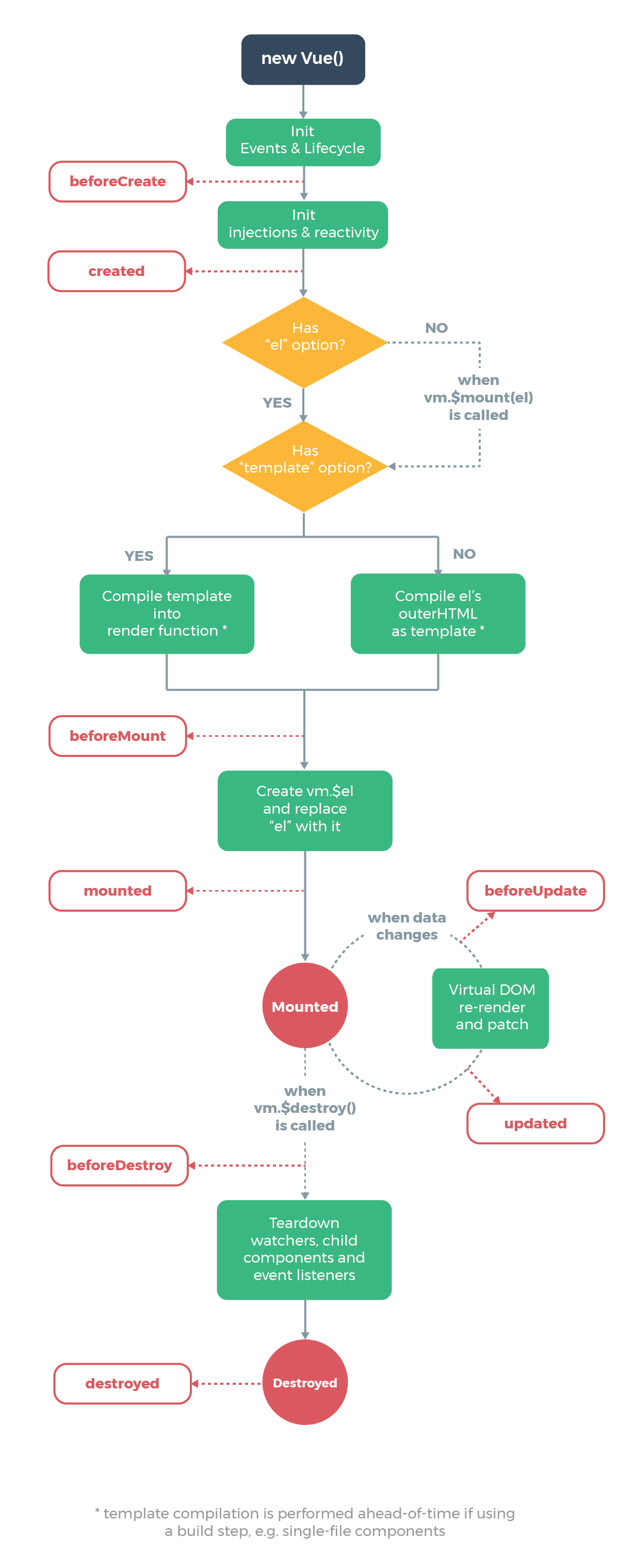
1.14.2 vue生命周期分析
-
初始化显示
beforeCreate()created()beforeMount()mounted()
-
更新状态:
this.xxx=valuebeforeUpdate()updated()
-
销毁
Vue实例:vm.$destory()beforeDestory()destoryed()
1.14.3 示例代码
<!DOCTYPE html> <html lang="en"> <head> <meta charset="UTF-8"> <meta http-equiv="X-UA-Compatible" content="IE=edge"> <meta name="viewport" content="width=device-width, initial-scale=1.0"> <title>分析生命周期</title> <script src="../js/vue.js"></script> </head> <body> <div id="root"> <h2 v-text="n"></h2> <h2>n 的值: {{ n }}</h2> <button @click="addN">点我 n + 1</button> <br/> <button @click="destroy">点我销毁 Vm</button> </div> <script> // 阻止 vue 在启动时生成生产提示 Vue.config.productionTip = false const vm = new Vue({ el: "#root", data: { n: 1 }, methods: { addN() { this.n++ }, destroy() { console.log("bye...bye... "); // 销毁 vm 的方式 this.$destroy() } }, watch: { n() { console.log("n 的值发生改变"); } }, // 数据监测、数据代理之前,此时无法通过 vm 访问到 data 中的数据、methods 中的方法 beforeCreate() { console.log("beforeCreate... ") console.log("beforeCreate... ", this, this.n) // this.n undefined // debugger; }, // 数据监测、数据代理之后,此时可以通过 vm 访问到 data 中的数据、methods 中的方法 created() { console.log("created... "); console.log("created... ", this, this.n); // debugger; }, // 此时页面呈现的是未经 Vue 编译的 DOM 结构,所有对 DOM 的操作,最终都不奏效 beforeMount() { console.log("beforeMount... "); // debugger; // 模板尚未解析 }, // 此时页面中呈现的经 Vue 编译的 DOM,对 DOM 的操作均有效(尽可能避免) // 至此初始化过程结束 // 一般在此进行:开启定时器、发送网络请求、订阅消息、绑定自定义事件等初始化工作 mounted() { console.log("mounted... ") // debugger; }, // 此时数据是新的,但页面是旧的,即页面尚未和数据保持同步 beforeUpdate() { console.log("beforeUpdate... ") // debugger; }, // 此时数据是新的,但页面也是新的,即页面和数据保持同步 updated() { console.log("updated... ") // debugger; }, // 此时 Vm 中的所有 data、methods、指令等等,都处于可用状态,马上要执行销毁过程 // 一般在此进行:关闭定时器、取消订阅消息、解绑自定义事件等 beforeDestroy() { console.log("beforeDestroy... ") // debugger; }, // 销毁 vm 实例 destroyed() { console.log("destroyed... ") }, }) </script> </body> </html> 1.14.4 常用的生命周期方法
mounted(): 发送ajax请求,启动定时器等异步任务beforeDestory(): 做收尾工作,如:清除定时器

